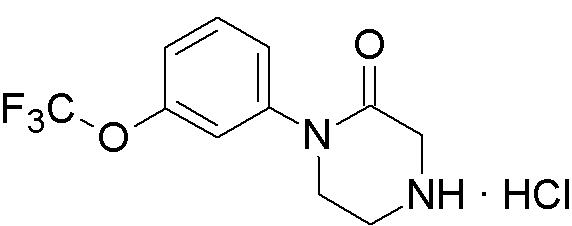1-(3-(Trifluoromethoxy)phenyl)piperazin-2-one hydrochloride is widely utilized in research focused on:
- Pharmaceutical Development: This compound is often explored for its potential as a therapeutic agent in treating various neurological disorders, offering a unique mechanism of action that may enhance efficacy compared to traditional treatments.
- Neurotransmitter Modulation: It plays a role in studies aimed at modulating serotonin and dopamine pathways, which are crucial for understanding mood disorders and developing antidepressants.
- Drug Design: Researchers leverage its structural properties in the design of new drugs, particularly in the development of selective receptor modulators that can lead to fewer side effects.
- Biochemical Research: The compound is used in biochemical assays to investigate receptor interactions, providing insights into cellular signaling pathways and potential therapeutic targets.
- Material Science: Its unique chemical properties make it a candidate for developing advanced materials, such as coatings or polymers, that require specific chemical resistance or stability.
General Information
Properties
Safety and Regulations
Applications
1-(3-(Trifluoromethoxy)phenyl)piperazin-2-one hydrochloride is widely utilized in research focused on:
- Pharmaceutical Development: This compound is often explored for its potential as a therapeutic agent in treating various neurological disorders, offering a unique mechanism of action that may enhance efficacy compared to traditional treatments.
- Neurotransmitter Modulation: It plays a role in studies aimed at modulating serotonin and dopamine pathways, which are crucial for understanding mood disorders and developing antidepressants.
- Drug Design: Researchers leverage its structural properties in the design of new drugs, particularly in the development of selective receptor modulators that can lead to fewer side effects.
- Biochemical Research: The compound is used in biochemical assays to investigate receptor interactions, providing insights into cellular signaling pathways and potential therapeutic targets.
- Material Science: Its unique chemical properties make it a candidate for developing advanced materials, such as coatings or polymers, that require specific chemical resistance or stability.
Documents
Safety Data Sheets (SDS)
The SDS provides comprehensive safety information on handling, storage, and disposal of the product.
Product Specification (PS)
The PS provides a comprehensive breakdown of the product’s properties, including chemical composition, physical state, purity, and storage requirements. It also details acceptable quality ranges and the product's intended applications.
Certificates of Analysis (COA)
Search for Certificates of Analysis (COA) by entering the products Lot Number. Lot and Batch Numbers can be found on a product’s label following the words ‘Lot’ or ‘Batch’.
*Catalog Number
*Lot Number
Certificates Of Origin (COO)
This COO confirms the country where the product was manufactured, and also details the materials and components used in it and whether it is derived from natural, synthetic, or other specific sources. This certificate may be required for customs, trade, and regulatory compliance.
*Catalog Number
*Lot Number
Safety Data Sheets (SDS)
The SDS provides comprehensive safety information on handling, storage, and disposal of the product.
DownloadProduct Specification (PS)
The PS provides a comprehensive breakdown of the product’s properties, including chemical composition, physical state, purity, and storage requirements. It also details acceptable quality ranges and the product's intended applications.
DownloadCertificates of Analysis (COA)
Search for Certificates of Analysis (COA) by entering the products Lot Number. Lot and Batch Numbers can be found on a product’s label following the words ‘Lot’ or ‘Batch’.
*Catalog Number
*Lot Number
Certificates Of Origin (COO)
This COO confirms the country where the product was manufactured, and also details the materials and components used in it and whether it is derived from natural, synthetic, or other specific sources. This certificate may be required for customs, trade, and regulatory compliance.

